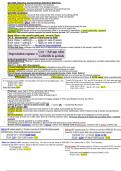Other
BACC211 Final outline
- Course
- BACC211
- Institution
- Suny Albany
The document is a detailed review guide for Financial Accounting, covering key topics like adjusting journal entries , factors in computing depreciation, book value, the types of taxes there are and different types of bonds. It includes sample exam questions similar to how it is on the test.
[Show more]



